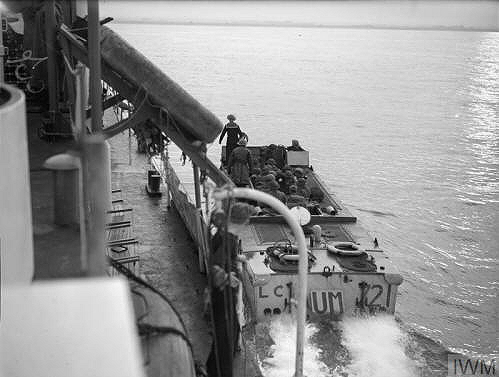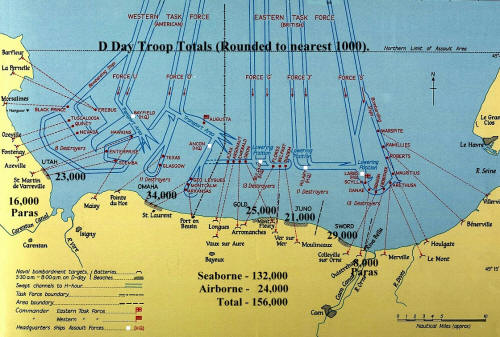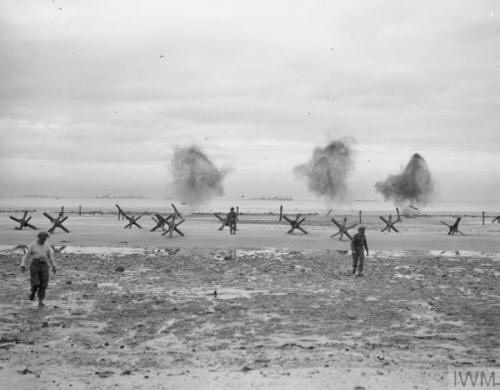|
519 Landing Craft Assault Flotilla - 519 LCA Flotilla.
6 Troop Carrying LCAs, then 5, then
4.
 Background Background
Leonard Albert King was just 20 years old
when he piloted
his flat bottomed Landing Craft Assault
(LCA)
to
the Normandy beaches,
early on D-Day morning.
Although he
was amongst the first to land on the heavily defended beaches,
his account belies the extremely hazardous position of his craft. This account
is based upon
the diary he maintained
for several weeks around this time.
[Photo;
Assault landing craft leaving an infantry carrying craft (mother ship) as they
prepare to make their way to the landing beaches. © IWM (A 23113).
Barry Miller confirms that the craft was LCA 721 of the 521 Assault Flotilla
from the Ulster Monarch, hence the “UM” sign].
LCAs were not designed to travel long
distances in open seas.
Accordingly, they were
usually
carried to the landing beaches on mother
ships, not unlike modern lifeboats, suspended from davits. Len's mother ship was the
SS Princess Maud,
which, pre war, had been a railway
ferry
that plied the waters between Stranraer,
in south west Scotland,
and
Larne in Northern Ireland.
She had been requisitioned for war service and
converted to a troop carrier with additional capacity to carry 6 LCAs, each
with a
capacity
about 35fully armed troops.
These early
designed
LCAs were constructed of
wood,
with some armour plating for protection against rifle and machine gun fire.
They were powered by two Ford V8 engines
driving twin screws
to produce a
cruising speed of 7 knots.
Her crew of four
comprised a coxswain, mechanic, gunner and sheets man (?).
 D-Day D-Day
On the night of 5 June,
1944, after a delay of 24 hours
due to bad weather, we set off for Omaha beach near the town of Vierville
as part of 519 LCA Flotilla.
We
were escorted by destroyers, cruisers and other battle ships as part of
the American 'Western Task Force' invading
Utah & Omaha beaches,
while the British and Canadian
'Eastern Task Force' invaded Gold, Juno &
Sword.
SS Princess
Maud carried several hundred Yankee soldiers, mainly demolition men to clear
beach obstacles in advance of the initial
assault troops. The obstacles
were designed to hinder the progress of the invading forces
as they approached and crossed the landing beaches.
The obstacles included
ramps, hedgehogs, stakes and element C. These brave men had their own specialised
'Landing Craft Mechanised' (LCMs) to transport
them to the beaches, where they
would face enemy machine gun fire and mortar bombs, while they went about their
work. Our job was to
pick up American troops
from other troop carriers and transport them to predetermined positions on the
landing beaches.
The crossing of the English
Channel was rough and we hoped it would settle before we beached our small vulnerable craft.
As we neared France, Allied bombers, with fighter escorts, dropped bombs to soften
up the landing beaches in advance of the initial assault force. We could see enemy ack ack
fire in response. Unbeknown to us at the time, a few thousand paratroopers had
already been dropped behind enemy lines.
 We reached our rendezvous
point about 03.00 hours on June 6th. American troops of the 1st
battalion, 116th US Infantry loaded into LCMs secured alongside. At about 0400 hrs,
we manned our craft and were lowered into the rough waters.
Manoeuvring our flat bottomed craft was difficult with 3 foot waves and a heavy swell. Water
sprayed over our boat as we headed for the Empire Javalon, a nearby LCA/troop
carrier. We were hoisted up to embark men of the US 5th
Ranger Battalion. We reached our rendezvous
point about 03.00 hours on June 6th. American troops of the 1st
battalion, 116th US Infantry loaded into LCMs secured alongside. At about 0400 hrs,
we manned our craft and were lowered into the rough waters.
Manoeuvring our flat bottomed craft was difficult with 3 foot waves and a heavy swell. Water
sprayed over our boat as we headed for the Empire Javalon, a nearby LCA/troop
carrier. We were hoisted up to embark men of the US 5th
Ranger Battalion.
[Extract from the Admiralty's 'Green List' opposite, shows
the 519 LCA
Assault
Flotilla was due to go to Juno beach but
for D-Day
was loaned to
the Americans at
Omaha].
Once fully loaded with our
complement of troops, we were lowered into the water. On return to the
vicinity of our own ship,
SS Princess Maud, the LCMs were still loading the demolition teams.
Their craft were
tossed up and down like corks, banging against the ship's side with securing lines parting and
being replaced. The men looked precarious,
as they climbed down scaling ladders
with their heavy gear on their backs.
The difference between the British and
American embarking
procedures was dramatic in these rough conditions. However, the British
procedures were not without their own problems. One of our craft, by then fully loaded
with troops, was floundering and in danger of sinking. Although not apparent
until the craft was back in the water, she had been holed during hoisting aboard
the Empire Javalon. Her
crew refused to hoist her back! Fortunately, the
coxswain remained calm and
circled Princess Maud until everyone, troops and crew, disembarked. Shortly
after, the LCA nose-dived beneath the waves.
 As daybreak broke, we could
see the awe-inspiring sight of thousands of ships and craft preparing to transport the troops and their equipment to the
landing beaches. The battleships, cruisers
and rocket craft bombarded the coast to
further soften up the enemy defences. The time came
for our remaining 5
craft to make for our designated landing beaches. At first we made
good progress but our Flotilla Officer’s (FO's)
craft took on water and started to go down by the bows. In an attempt to steady the craft and reduce water ingress, the
coxswain manoeuvred the craft to put its stern to the weather but the unstable LCA
capsized. As daybreak broke, we could
see the awe-inspiring sight of thousands of ships and craft preparing to transport the troops and their equipment to the
landing beaches. The battleships, cruisers
and rocket craft bombarded the coast to
further soften up the enemy defences. The time came
for our remaining 5
craft to make for our designated landing beaches. At first we made
good progress but our Flotilla Officer’s (FO's)
craft took on water and started to go down by the bows. In an attempt to steady the craft and reduce water ingress, the
coxswain manoeuvred the craft to put its stern to the weather but the unstable LCA
capsized.
[Photo; Leonard Albert King].
The
Flotilla Officer (FO), crew and most of the soldiers
were picked up by the remaining 4 boats and we proceeded towards the beach. As we drew closer, the more
hazardous became our position
from shells, mortars and machine gun fire. Many craft around us succumbed to the deadly fire, some
capsizing. There were many casualties but we had to focus on our mission. Our 4
remaining craft successfully disembarked our troops and succeeded in un-beaching; but not without damage. One of our
boats was riddled with bullet holes, with
a 4 inch shell embedded in a battery, which put the port engine out of action.
Some
craft from our
flotilla were
picked up by the Prince Charles, an LCA/troop carrier, which happened to be quite close to the beach attempting to rescue
some of her own badly damaged LCAs. Another
of our LCAs was picked up by Princess Maud, as
the crew baled out as though their lives
depended upon their labours. Our fourth craft, Nobby’s,
was picked up by yet another ship.
 We
met up with Nobby that
evening in Cowes
on the Isle of Wight. The bow of his craft was badly mangled
and in the relative safety of home waters, we found it difficult to accept
the reality of the noise, violence, death and destruction of total war
we had witnessed. We had a rough time but we survived. Others
performing similar duties, were
not
so lucky. We
met up with Nobby that
evening in Cowes
on the Isle of Wight. The bow of his craft was badly mangled
and in the relative safety of home waters, we found it difficult to accept
the reality of the noise, violence, death and destruction of total war
we had witnessed. We had a rough time but we survived. Others
performing similar duties, were
not
so lucky.
[Photo;
Royal Navy Commandos of the Landing Craft Obstacle
Clearance Units running to get clear while obstacles are blown up at
La Riviere. Some of the invasion ships can be seen on the horizon. ©
IWM (A 23993). Similar work was undertaken by US Engineers on Omaha
and Utah].
One of our lads, 'Shorty' Griffin,
was reported missing
but later found to be in Hospital having been plucked from the sea by an LCT. There was little time for rest and recuperation. Next day, 4 new LCAs
were delivered, replacing those lost or damaged
and we sailed round to Portland for more troops.
Post D-Day
Our second trip to Normandy was on June
10th, when we carried military police (MPs), doctors and medical orderlies
to Utah, the second American beach. It was less hazardous this time,
since the enemy beach defences had been cleared, although we were still
vulnerable to mines, shells and strafing by the Luftwaffe.
We arrived about 0400 hrs as landing craft of many
types unloaded stores, munitions
and supplies. We landed on an ebbing tide, so quickly
disembarked our human cargos to avoid being stranded high and dry. Despite our
best efforts, 2 of our craft were stranded until the next tide. On D-Day, these craft would have been picked off like sitting ducks by shell fire
and mortar bombs. However, on this trip, it was more of an inconvenience, as vital
landing space was unnecessarily taken up on the busy beachhead.
Mine clearing work was still
in progress off the beaches and one
mine was detonated fairly close to our position. We were hoisted
back on board our mother craft and spent the night just offshore. An LCT came
alongside loaded with British Troops of the Pioneer Corp, who had previously had a wet landing when their craft stuck on a sand bar a few
metres from the shore. At dawn, we took them to their landing beach, this time giving them a
dry landing! Amongst their number were 2 stretcher cases and a soldier with
a broken arm. We carried them back to England
for hospital treatment.
Back at Portland,
we embarked another 850 men of US Army on to
our mother ship and safely delivered them to France on June the 13th. It
was an uneventful round trip although, on the return leg, we zig-zagged to avoid
a reported U-boat. With 3
days ashore, we went on the razzle and to the dances! The 2 stranded LCAs returned safely. At 0200 on June the 18th, we departed with more American
troops, landing them without incident in France at about 11.00 hrs, this time directly on
to a pontoon pier.
En route for
Newhaven, we saw a doodlebug fly over in the general direction of England
and heard on the radio that one of our ships had been
torpedoed, although 3
destroyers were on hand to pick up survivors. Back at Newhaven,
we picked up about 800 British soldiers, Welsh Guards and Pioneers. We made for
Portsmouth, where we joined a convoy
to the British/Canadian sector near Arromanche,
which was now served by a
harbour made of concrete blocks - one of two 'Mulberry Harbours.'
Next morning
we joined a homeward convoy, during which we
saw minesweepers in action clearing
mines laid by the Germans during the hours of darkness. Two were detonated in the middle
distance. After visiting Netley on the approaches to Southampton, to store up and refuel,
we proceeded to Cowes for a welcome spell of shore leave.
We
then transported
British troops from the North and South Staffs and the Royal Norfolks of Monty’s 2nd
Army. We passed by the protruding bows of two sunken Liberty Ships; a reminder that
easy passage across the channel could not be taken for granted. We disembarked at noon on June the 28th, men and bicycles. On our convoy home, another LCA/troop
carrier, the Maid of Orleans, was sunk by a mine. Five men in the engine room were killed but
the remaining crew were picked up by destroyers.
We docked at Cowes and later
embarked a Leicester Regiment and 6 patrol dogs at
Southampton. The weather was pretty rough but we successfully landed our troops,
returned to Southampton, embarked American infantry, electricians and
20 nurses; the first women to come aboard and
landed them all on the beaches, since the pontoons we
had been using were high and
dry. Some craft became stuck on
the sand but we returned to our mother craft, sailed home to Cowes and enjoyed some shore leave.
On 12 July, we picked up 450 British troops, our official
carrying capacity, as opposed to the
800 or more on previous trips. We landed them on 14 July in comparative peace,
needing only 3 return trips for each craft.
Len's diary ended at this
point, most likely because the trips to France had become much safer and routine.
The use of LCAs continued until larger ships could safely use functioning ports
captured from the Germans.
Postscript
In Nov 1944, Acting Temporary
Leading Seaman, Leonard King, service no C/JX 379424, was awarded a DSM (Distinguished Service Medal) for an action
during Operation Infatuate, the assault on the
heavily defended island of Walcheren in the Scheldt estuary. While the island
remained in enemy hands, the Allies were unable to use the port of Antwerp which
had fallen to them. It was of great strategic importance in the supply chain to the Allied
armies, by then advancing towards Germany.
Further Reading
On this website there are around 50
accounts of landing craft
training and operations and
landing craft training establishments.
There are around 300 books listed on our 'Combined Operations Books' page which can be
purchased on-line from the Advanced Book Exchange (ABE) whose search banner
checks the shelves of thousands of book shops world-wide. Type in or copy and
paste the title of your choice or use the 'keyword' box for book suggestions.
There's no obligation to buy, no registration and no passwords. Click
'Books' for more information.
Acknowledgements
We're very grateful to Ray King for sight of his brother's diary on which this
webpage is based. The text was approved by Ray before the webpage
was published.
Photos and maps have subsequently been added.
|






